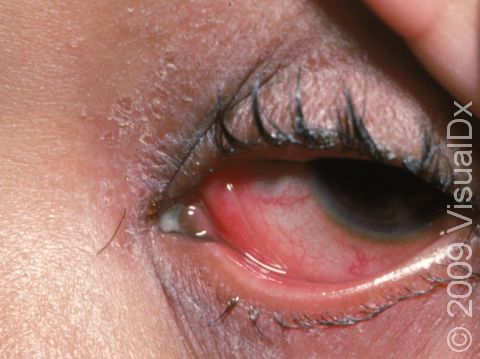Pink Eye (Conjunctivitis)
Conjunctivitis, commonly known as pink eye, is an inflammation of the tissue on the surface of the eye and/or the inside lining of the eyelids. Common causes of pink eye in children are infection with bacteria, viruses, allergies, or environmental irritants such as chemicals, fumes, dust, or debris. Eye injury can also result in a pink or red eye that is bothersome to the child, sometimes causing visual problems.
Who's At Risk?
Pink eye is very common. Infectious forms of conjunctivitis among children are particularly common as they often play in close proximity and share many items. Because children may not be aware of what irritates their eyes, they may routinely be exposed to allergens and irritants that cause conjunctivitis. An adult often needs to make the connection between the allergen or irritant and the reaction in a child.
Signs & Symptoms
- The eye is usually pink or red and appears irritated.
- Infectious conjunctivitis affects one or both eyes and may be accompanied by discharge (tears, mucus, or pus). The eyelids may be stuck together in the morning upon waking, and goopy discharge may continue to accumulate through the day.
- Allergic conjunctivitis usually affects both eyes and can cause tearing, and the child may want to rub their eyes frequently. The area around the eyes may be swollen from the constant rubbing. Sometimes the child will also have other allergic symptoms that occur during the allergy seasons, such as a chronic runny nose, constant tickle in the throat, and sneezing.
- Irritant conjunctivitis can cause burning, itching, a sandy or gravely feeling, and even pain in the eye.
- Conjunctivitis due to injury to the eye can cause tearing, pain, sensitivity to bright light, and changes in vision or loss of vision.
Self-Care Guidelines
- Have your child wash their hands frequently to avoid contaminating others and reinfecting themself.
- Separate your child’s towels, washcloths, and blankets from the rest of the household’s items so that others will not be at risk.
- Cold compresses can sometimes help relieve eye itching and swelling.
- Wash the child’s eyelids and very gently remove debris; do not pick at it.
- Encourage the child to stop rubbing their eyes.
- Note that over-the-counter eye medications should not be used in children without first checking with their medical professional.
- If your child’s eyes have been exposed to debris or an irritant, thoroughly wash the eyes with water.
Treatments
Treatment of pink eye depends on the cause of the conjunctivitis (eg, virus, bacterium, allergy). No treatment may be necessary. However, a topical antibiotic, anti-inflammatory, or antiallergy drops may all be prescribed. Make sure your child completes the full prescribed course as directed. If the pink eye is related to another disease elsewhere in the body (such as allergies, an ear infection, or respiratory disease), oral medications may be prescribed.
Visit Urgency
You should take your child to their medical professional if:
- Discharge from the eye is worsening.
- There is severe pain or light sensitivity.
- Swelling is increasing.
- There are problems with the child’s vision.
- There is difficulty or inability to move the eyes around.
- There is blistering and/or a rash on the eyelids.
- There has been any injury to the eye.
- The child has a prolonged gritty sensation in one or both eyes.
- The condition is not getting better within a week.
- The child has a fever in addition to the pink eye.
References
Duncan JL, Parikh NB, Seitzman GD. Conjunctivitis. In: Papadakis MA, McPhee SJ, Rabow MW, McQuaid KR, Gandhi M, eds. Current Medical Diagnosis & Treatment 2024. McGraw Hill; 2024.
Horton JC. Disorders of the eye. In: Loscalzo J, Fauci AS, Kasper DL, Hauser SL, Longo DL, Jameson JL, eds. Harrison’s Principles of Internal Medicine. 21st ed. McGraw Hill; 2022.
National Center for Immunization and Respiratory Diseases (NCIRD), Division of Viral Diseases. Conjunctivitis (pink eye). Centers for Disease Control and Prevention. https://www.cdc.gov/conjunctivitis/index.html. Updated 2021 Nov 12.
Last modified on June 20th, 2024 at 7:47 am

Not sure what to look for?
Try our new Rash and Skin Condition Finder
